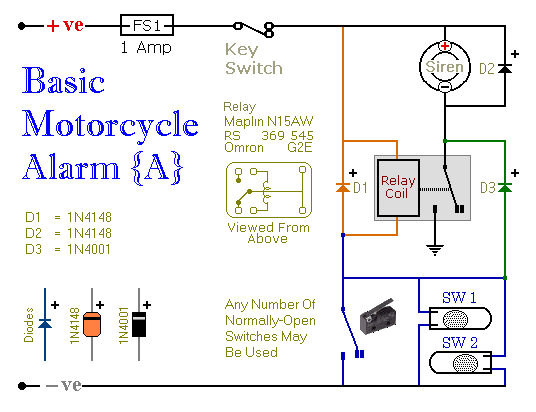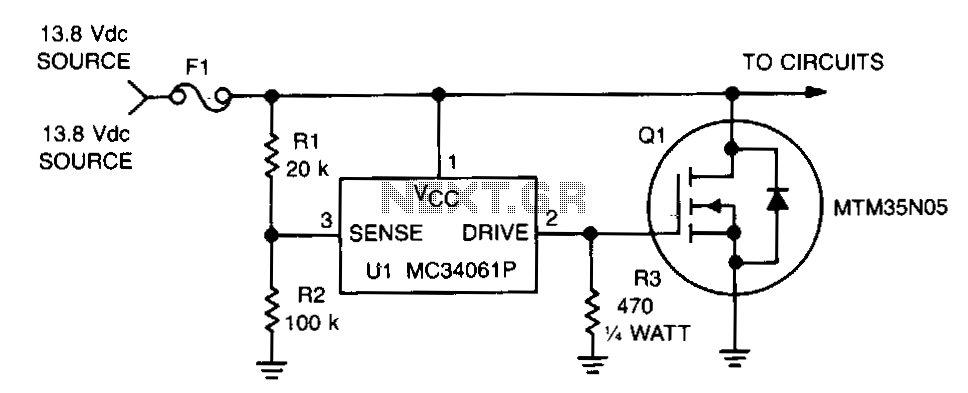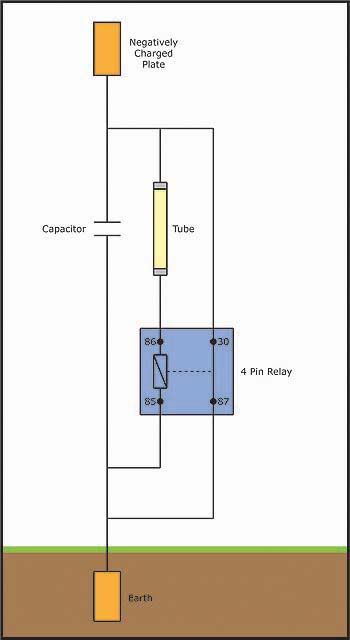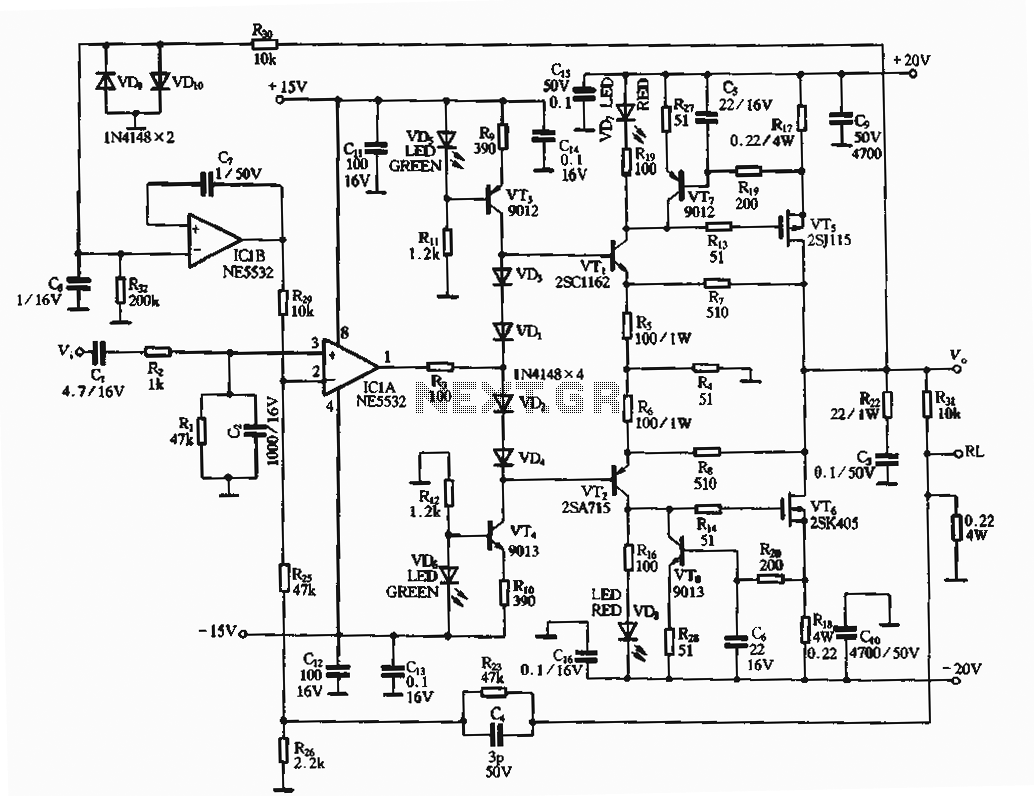
Mains voltage bidirectional limit alarm protection circuit diagram
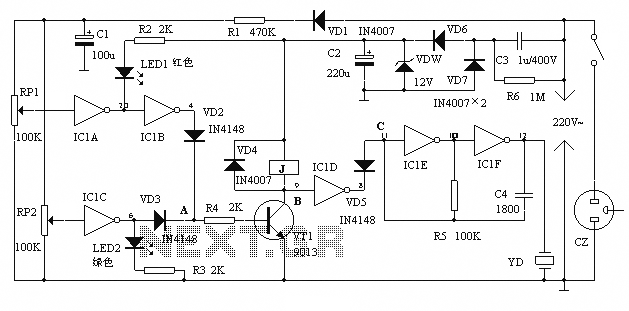
The alarm protection can trigger a sound and light alert when the mains voltage exceeds or falls below a predetermined threshold. It automatically disconnects the electrical power supply without damaging the electrical protection. The device is compact, fully featured, and practical. The circuit diagram is illustrated in Figure 1. The mains voltage is processed through C3 to a buck converter, followed by a voltage regulator (DW), with VD6 and VD7 rectifying the output to provide a stable 12V DC supply. Another pathway involves VD1 for rectification, R1 for bucking, and C1 for filtering to yield approximately 10.5V for detecting variations in mains voltage through input signals on RP1 and RP2. The IC1A and IC1B form an overvoltage detection circuit, while IC1C detects undervoltage. IC1D is responsible for switching, and IC1E, IC1F, along with YD piezoelectric ceramics, create an audio pulse oscillator. Transistors (VT) and other components operate the relay (J) for circuit protection. LED1 indicates mains overvoltage in red, while LED2 shows normal mains voltage in green. Under normal conditions, IC1A outputs high, and IC1B and IC1C output low, resulting in LED1 and LED2 being off, VT in cutoff, and relay J inactive, allowing normal power supply operation. When mains voltage is either too high or too low, IC1B or IC1C output high signals, leading to a high potential at point A, saturating VT, and activating relay J to disconnect power. Consequently, point B becomes low, IC1D outputs high, VD5 turns off, and the audio pulse oscillator starts, causing the YD alarm to sound and the corresponding LED indicator to light up. During debugging, a power supply regulator set to 220V with an incandescent lamp as a load will keep LED1 and LED2 off. Adjusting the upper or lower limits on the regulator while modifying RP1 or RP2 will turn on LED1 or LED2 and turn off the incandescent lamp, indicating successful commissioning. All components can be housed in a small plastic enclosure, with holes for securing the LEDs on the lid and a larger hole for the piezoelectric ceramics, which can be tuned with an appropriate cap to enhance sound output.
The circuit operates on the principle of voltage monitoring and protection. The input voltage is first reduced and stabilized to ensure the circuit functions reliably. The buck converter and voltage regulator work together to maintain a constant output voltage, which is crucial for the operation of the detection circuits. The overvoltage and undervoltage detection circuits (IC1A, IC1B, IC1C) are designed to respond quickly to fluctuations in the mains voltage, ensuring that any dangerous conditions are addressed immediately.
The relay (J) serves as the primary mechanism for disconnecting the power supply when an unsafe voltage level is detected. The use of transistors (VT) allows for rapid switching, which is essential for protecting sensitive electronic devices from damage due to voltage irregularities. The incorporation of piezoelectric ceramics for the alarm sound provides a reliable and loud indication of alarm conditions, ensuring that the user is alerted promptly.
The LED indicators (LED1 and LED2) provide a visual representation of the system's status. Their operation is directly tied to the outputs of the detection circuits, allowing users to easily determine whether the mains voltage is within safe limits. The design's compact nature allows for easy integration into various environments, making it suitable for both residential and commercial applications.
Overall, the circuit is designed for maximum efficiency and reliability, ensuring that it can effectively protect electrical devices from damage due to voltage fluctuations while providing clear alerts to users.When the alarm protection can be higher or lower than the predetermined value in the mains voltage, sound and light alarm, and automatically cut off the electrical power, electrical protection is not damaged. The device is small, full-featured, making simple and practical. Circuit shown in Figure 1. Mains voltage all the way from C3 Buck, DW regulator, VD6, VD7, C2 rectifier output stable 12V DC voltage supply circuit. Another route VD1 rectified, R1 buck, C1 filtered to produce about 10.5V voltage detection mains voltage variations in the input signal on RP1, RP2.
Door IC1A, IC1B composition overvoltage detection circuit, IC1C undervoltage detection, IC1D switching, IC1E, IC1F and YD piezoelectric ceramics composed audio pulse oscillator. VT transistors and other components and relay J circuit protection action. LED1 red for mains overvoltage indication LED2 green pipe for mains voltage indicator.Mains normal, non IC1A output high, IC1B, IC1C output low, LED1, LED2 are turned off does not emit light, VT cutoff, J does not operate, the normal electrical power supply, then point B is high, F4 output low, VD5 conduction, C point is low, audio pulse oscillator to stop, YD not sound.
When the mains overvoltage or undervoltage, IC1B, IC1C which has a high output, so point A goes high, VT saturated conduction, J pull power, disconnect the electrical power supply, the point B becomes low potential, IC1D output high, VD5 off, reverse resistance is large, the equivalent of an open circuit, audio pulse oscillator start-up, YD alarm will sound, and the corresponding light-emitting diode light indication. When debugging, using a power supply regulator, the voltage regulator is normal (220V), with an incandescent lamp as a load, make LED1, LED2 are off, incandescent light, and then the upper or lower limit on the regulator raised , adjust RP1 or RP2 make LED1 or LED2 just light, incandescent lamp off, the successful commissioning.All components can be installed in a small plastic box, will play two holes fixed LEDs on the lid, make a little hole larger fixed piezoelectric ceramics, and with an appropriate cap to the piezoelectric substrate was used as an aid tune to have loud chirping.
The circuit operates on the principle of voltage monitoring and protection. The input voltage is first reduced and stabilized to ensure the circuit functions reliably. The buck converter and voltage regulator work together to maintain a constant output voltage, which is crucial for the operation of the detection circuits. The overvoltage and undervoltage detection circuits (IC1A, IC1B, IC1C) are designed to respond quickly to fluctuations in the mains voltage, ensuring that any dangerous conditions are addressed immediately.
The relay (J) serves as the primary mechanism for disconnecting the power supply when an unsafe voltage level is detected. The use of transistors (VT) allows for rapid switching, which is essential for protecting sensitive electronic devices from damage due to voltage irregularities. The incorporation of piezoelectric ceramics for the alarm sound provides a reliable and loud indication of alarm conditions, ensuring that the user is alerted promptly.
The LED indicators (LED1 and LED2) provide a visual representation of the system's status. Their operation is directly tied to the outputs of the detection circuits, allowing users to easily determine whether the mains voltage is within safe limits. The design's compact nature allows for easy integration into various environments, making it suitable for both residential and commercial applications.
Overall, the circuit is designed for maximum efficiency and reliability, ensuring that it can effectively protect electrical devices from damage due to voltage fluctuations while providing clear alerts to users.When the alarm protection can be higher or lower than the predetermined value in the mains voltage, sound and light alarm, and automatically cut off the electrical power, electrical protection is not damaged. The device is small, full-featured, making simple and practical. Circuit shown in Figure 1. Mains voltage all the way from C3 Buck, DW regulator, VD6, VD7, C2 rectifier output stable 12V DC voltage supply circuit. Another route VD1 rectified, R1 buck, C1 filtered to produce about 10.5V voltage detection mains voltage variations in the input signal on RP1, RP2.
Door IC1A, IC1B composition overvoltage detection circuit, IC1C undervoltage detection, IC1D switching, IC1E, IC1F and YD piezoelectric ceramics composed audio pulse oscillator. VT transistors and other components and relay J circuit protection action. LED1 red for mains overvoltage indication LED2 green pipe for mains voltage indicator.Mains normal, non IC1A output high, IC1B, IC1C output low, LED1, LED2 are turned off does not emit light, VT cutoff, J does not operate, the normal electrical power supply, then point B is high, F4 output low, VD5 conduction, C point is low, audio pulse oscillator to stop, YD not sound.
When the mains overvoltage or undervoltage, IC1B, IC1C which has a high output, so point A goes high, VT saturated conduction, J pull power, disconnect the electrical power supply, the point B becomes low potential, IC1D output high, VD5 off, reverse resistance is large, the equivalent of an open circuit, audio pulse oscillator start-up, YD alarm will sound, and the corresponding light-emitting diode light indication. When debugging, using a power supply regulator, the voltage regulator is normal (220V), with an incandescent lamp as a load, make LED1, LED2 are off, incandescent light, and then the upper or lower limit on the regulator raised , adjust RP1 or RP2 make LED1 or LED2 just light, incandescent lamp off, the successful commissioning.All components can be installed in a small plastic box, will play two holes fixed LEDs on the lid, make a little hole larger fixed piezoelectric ceramics, and with an appropriate cap to the piezoelectric substrate was used as an aid tune to have loud chirping.
